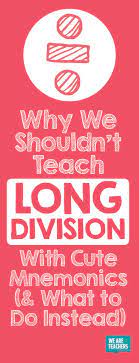Across the world, students struggle to grasp the concept of long division. Teachers and parents try their best to help them remember the process with techniques such as cute mnemonics. While these shortcuts may seem useful at first, they don’t provide a solid foundation for true mathematical understanding, and even may hinder students from developing skills beyond memorization. This article highlights why we shouldn’t rely on cute mnemonic devices for teaching long division and offers alternative methods that better foster deep learning.
The Limitations of Mnemonics
Mnemonics are memory aids that help students learn complex concepts by associating them with simpler ideas or words. A popular mnemonic for long division is “DMSB,” which stands for divide, multiply, subtract, and bring down. While this acronym may seem like an efficient way to approach long division, it has numerous downsides:
1. Lack of Conceptual Understanding: Relying on mnemonics doesn’t encourage students to engage with the underlying concepts behind division – it only helps them follow a set pattern without truly understanding what they’re doing.
2. Inability to Solve Complex Problems: As students progress in mathematics, they’ll be faced with more intricate problems that cannot be solved with rote memorization alone. Without a firm grasp of long division principles, they’ll struggle to tackle advanced mathematical challenges effectively.
3. Fosters Dependency: Students who rely on mnemonics become dependent on them as learning crutches, preventing the development of critical thinking and problem-solving skills necessary for success in mathematics.
Alternatives to Mnemonics
To better equip students with long-lasting mathematical knowledge, teachers and parents can employ alternative teaching strategies that foster an understanding of the core concepts rather than relying on memory aids. Here are some methods that can replace mnemonic devices when teaching long division:
1. Visualization: Help students visualize the division process by using physical objects or diagrams. This can include using manipulatives such as base-ten blocks or drawing number lines. This hands-on approach allows students to grasp the true meaning of long division as they observe and interact with the concept in tangible ways.
2. Decomposition: Teach students to break down large numbers and divide them into smaller, more manageable parts. By dividing a problem into smaller subproblems, they develop number sense skills and better understand how to derive a quotient.
3. Real-world Examples: Connect the concept of long division to real-life situations that resonate with students. This can include splitting items among friends, dividing chores at home, or sharing resources in a community project. Demonstrating the importance of division in everyday life helps students make connections between abstract math concepts and real-world applications.
4. Practice and Persistence: Encourage students not to rely on mnemonic devices, but instead practice long division through repetition and persistence. Work together on a variety of problems to help them build confidence and understanding.
Conclusion
While mnemonic devices can aid in quick memorization, it’s crucial not to rely on them exclusively for teaching long division. In order for students to develop strong mathematical foundations, they must engage with core concepts and build their critical thinking abilities. By employing visualization techniques, decomposition strategies, real-world examples, and plenty of practice, we can prepare our children for mathematical success beyond just remembering cute mnemonics.





